History
“Be Our Guest” features an unvarnished take on Disney Company history

I have to admit that It's been kind of amusing to watch the
reaction (both here and elsewhere around the Web) that Tuesday's "What's really
behind the sudden change in Disney Parks & Resorts' facial hair policy"
story has been getting. With all sorts of would-be Disney scholars weighing on whether
The Happiest Place on Earth actually had an official policy in place in regards
to personal grooming when this theme park first opened to the public back on
July of 1955.
The harsh truth here is that – given that there had never,
ever been a Disneyland before (More importantly, given that Walt could & would
change his mind on how he wanted this place run with little or no notice) – the
initial rules of operation for the world's first theme park were kind of written
on the fly.
Which meant that – often totally by accident – a Disneyland
employee could suddenly find themselves in violation of a policy that hadn't actually
been written yet. In the recently revised and updated edition of "Be Our Guest: Perfecting the Art of Customer Service" (Disney Editions, November 2011), Theodore
Kinni writes about the poor publicist who – back in December of 1955 — ran
afoul of one of Walt's then-unwritten rules.
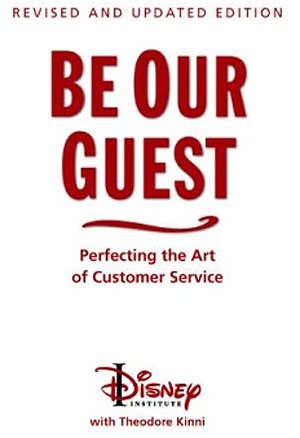
Copyright Disney Enterprises, Inc.
All rights reserved
Walt was always focused on providing a good show, one in
which the audience's attention was never unintentionally diverted or otherwise
interrupted. Marty Sklar, the now-retired Chairman of Walt Disney Imagineering,
remembered walking through Disneyland with Walt. As they reached the Mike Fink
Keel Boats in Frontierland, a company publicist drove up to the pair. Walt was
shocked. "What," he demanded, "are you doing with a car here in 1860?"
What's fun about this 208-page hardcover is – because this book
is written mostly for people in the corporate world who have now turned to the
Disney Institute for help in improving their company's customer service – there
are lots of stories in here about Mickey's earlier missteps. Moments where – in
order to deliver a more satisfying Guest experience — the Mouse had to change the
rules and/or actually create a whole new policy in order to address a specific
concern.
And given that "Be
Our Guest" offers more of a warts-and-all take on Disney Company history
(rather than the heavily edited & highly polished version of this story that
Mickey usually foists on the public), there's a lot of genuinely fascinating
material buried deep down in this book. Like that moment when Kelvin Bailey
(who – back in the early 1960s – was one of Walt
Disney Productions' official corporate pilots) reveals that – when he initially flew Walt down to Central
Florida to do a site inspection of all that property which the Company had just
purchased in Orange & Osceola County – Kelvin …
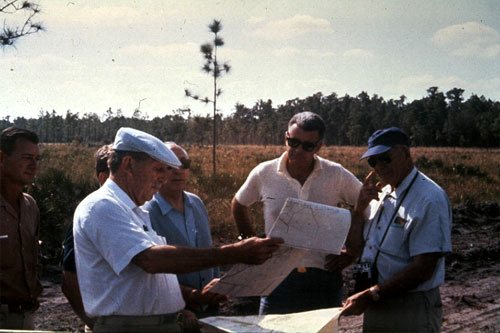
Walt during his onsite inspection of the then-undeveloped Florida Project property.
Copyright Disney Enterprises, Inc. All rights reserved
… was beginning to suspect that his boss might not be
playing with a full deck. "We drove ten or twenty miles and we got into this
nasty, wasted country," he recalls, "Water, swamps, jungle, alligators. I
thought, 'He's got to be out of his mind – this is nothing! Water up to our
knees!' You couldn't have given me the land."
Even though he would not live to see the land developed,
Walt had no trouble imagining it amid the Florida scrub. He pointed out Main
Street, U.S.A., Fantasyland, and other nonexistent features to the thoroughly
astounded pilot.
What's also enjoyable about "Perfecting the Art of Customer
Service" is that – at the very least, in passing – this book discusses those
private moments where Disney's confidence wavered. Where Walt wondered if the
organization that he & his brother had built up over the years actually had
the financial wherewithal to turn 40
square miles of swampland into a vacation destination. Which is why …
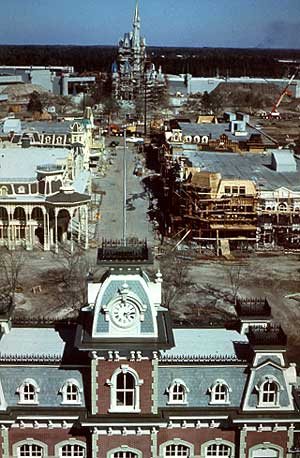
WDW's Magic Kingdom still under construction in the
Spring of 1971. Copyright Disney Enterprises, Inc.
All rights reserved
… In 1966, Walt and Roy briefly considered merging the
company with General Electric or Westinghouse in order to raise the estimated
$100 million in capital needed to build Walt Disney World.
Mind you, not all of the stories in this revised &
updated version of "Be Our Guest" key off of Walt's actions and thoughts in the
late 1950s / early 1960s. There are also lots of great more modern day
observations to be found in this book. Little bits of trivia that are sure to
delight & intrigue even the most dedicated of Disney fans. Take – for example
– the paragraph which talks about all of the care & thought that the
Imagineers put into the positioning of Disney's Wilderness Lodge.
I mean, I've long been a fan of this 728-room resort. I've
been visiting Wilderness Lodge since it first opened back in May of 1994. Hell,
if I'm remembering correctly, I think I actually got to visit this WDW hotel before
it officially opened to the public (To explain: My ex-wife and I were living in
Central Florida at the time. We were friendly with a lot of Disney World Cast
Members, which is how we were then invited to take part in Wilderness Lodge's pre-opening,
Cast-Member-Only "Open Mouse" event. Where – while toting our
then-two-month-old daughter along with us — we then toured this 8-story, log-structured
building from top to bottom).
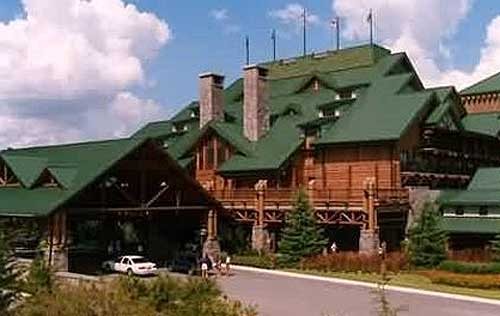
Copyright Disney Enterprises, Inc. All rights reserved
Anyway … I thought that I already knew Disney's Wilderness
Lodge Resort pretty well. But leave to Mr. Kinni and his keen eye for detail to
uncover an aspect of this hotel that I had never, ever noticed before.
The Wilderness Lodge is located right next to the
Contemporary Resort, but the modern world never imposes on the Lodge's American
West setting. Guests can't see the Contemporary; the view is purposely blocked.
They enter the lodge along a winding road that is flanked by tall pine trees
and dotted with old-fashioned streetlights and a BEAR CROSSING sign. If you
walk straight through the main lobby and out of the building, you can see a
long view over a completely undeveloped lake that is meant to remind guests of
the open spaces and natural wonders of the U.S. National Parks.
And it's not just the Disney theme parks & resorts that
you'll be viewing differently after reading "Be Our Guest: Perfecting the Art
of Customer Service." As you dig the revised and updated edition of this Disney
Institute-authorized book, you'll also come away with a renewed appreciation
for films like "Who Framed Roger Rabbit" and "WALL-E." More importantly, how
these particular Touchstone Pictures & Pixar Animation Studios productions continue
something that Walt used to do with the full-length animated features that Disney
Studios produced in the late 1930s & early 1940s. That extra little bit of attention-to-detail
which then made the movie magic seem that much more real. This now-decades-old
practice …
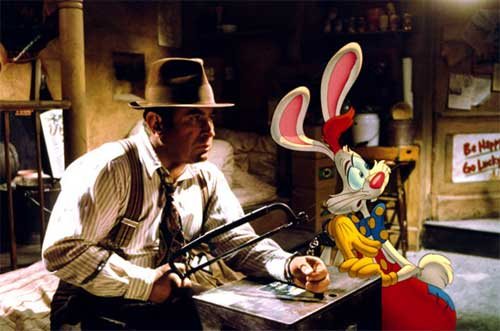
Copyright Touchstone Pictures / Amblin Entertainment, Inc. All rights reserved
… has been referred (in modern times, anyway) to as "bumping
the lamp."
Bumping the lamp was born during the filming of the Walt
Disney Pictures film "Who Framed Roger Rabbit." The film was an innovative mix
of live action and animation. In one scene, the movie's leading man, Bob
Hoskins, bumps into a lamp hanging from the ceiling. The lamp swings back and
forth, and so does its shadow. During the making of the film, the lamp appeared
in the live-action setting the same way it would in the natural world. But what
happened when the animated star, Roger Rabbit, was added to the scene? That's
right – no shadow crossed our wisecracking hero's face.
Most of the film's viewers would not notice the difference,
and certainly the scene could have been shot without Hoskins bumping into the
lamp. But the film's animation artists made sure that the shading on Roger
Rabbit accurately reflected the moving shadow cast by the live-action lamp in
each of the twenty-four frames in every second of the scene. They paid
attention to the details and took that extra step in their commitment to a quality
guest experience.
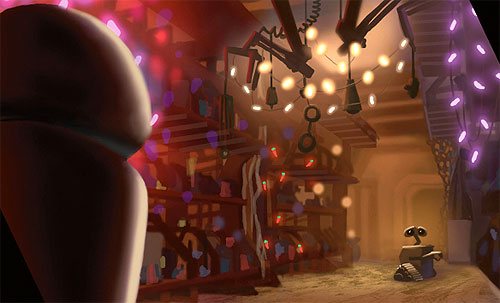
Concept art for the interior of WALL-E's home. Copyright Pixar Animation Studios.
All rights reserved
A more recent example of bumping the lamp can be found in a
scene in "WALL-E," a Pixar film about a lonely little robot that is left behind
to clean up Earth after humans have abandoned the planet. Nearly six miles of
cityscape were designed and built in a computer to make WALL-E's world
believable to audiences. WALL-E is a collector; in one scene, he returns to his
home after a day's work, and the audience sees this firsthand. In this single
scene, Pixar's animators populated WALL-E's home with 827 poker chips,
sixty-six license plates, 290 fake eyeballs, etc. The lighting sources in his
home include 798 Christmas lights, two chords of forty-eight chili lights, four
bug zappers, five paper lanterns, and ten tiki lights. No viewer could possibly
see all of these items. So why did Pixar include them? "It's the little
whispers that speak to an audience," explained director Andrew Stanton.
So if you're the type of person who actually enjoys hearing
those little whispers. Or – for that matter – if you like learning about those
moments where Walt flat-out yelled at his employees. Take – for example – what happened
back in 1956 when …
… it was suggested that an administration building be
erected for the management of Disneyland … Walt was vehemently opposed (to this
idea. He said that)"I don't want you guys sitting behind desks. I want you out
in the park, watching what people are doing and finding out how you can make
the place more enjoyable for them." When he found out that the staff was
leaving the property to eat, Walt steamed, "Stand in line with the people, and
for god's sake, don't go off the lot to eat like you guys have been doing. You
eat at the park and listen to the people."
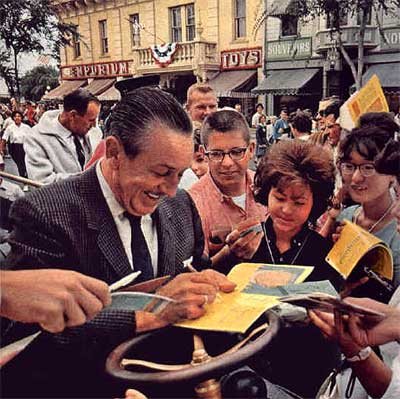
Walt practicing what he preached, getting out and interacting with the
public at Disneyland Park in the Fall of 1962. Copyright Disney
Enterprises, Inc. All rights reserved
If a book like this – which offers a far more unvarnished
take on Disney Company history than you usually get to read — sounds like something
that would appeal to you, that I urge you to pick up a copy of "Best Our Guest:
Perfecting the Art of Customer Service."
Just be aware that this Disney Editions publication is really
aimed more at the corporate crowd, rather than at Disney fans. Which is why you
may find yourself wading through pages & pages of self-serving corporate
speak like …
Clearly, all organizations need customer-friendly employees.
In fact, the number-one question that Disney Institute's corporate clientele
asks us is "Can you make our people nice?"

Copyright Disney Enterprises, Inc. All rights reserved
… before you'll then come across a gem like this which then
gives you a renewed appreciation for how the original Disneyland Park was designed.
John Hench, one of the original Imagineers (the folks who
design and build all of Disney's theme parks), remembers watching Walt finesse
a setting. "I was so astonished by the way Walt could create a kind of
live-action cross-dissolve when passing from one area of Disneyland to another.
He even insisted on changing the texture of the pavement at the threshold of
each new land because, he said, "You can get information about a changing
environment from the soles of your feet."
So if you want to get a better sense of how the first Disney
theme park actually came together, all of the trial & error involved with
getting The Happiest Place on Earth up out of the ground (More importantly,
what went into getting Disneyland's first set of Cast Members properly trained
and motivated), then get yourself a copy of "Be Our Guest: Perfecting the Art
of Customer Service."
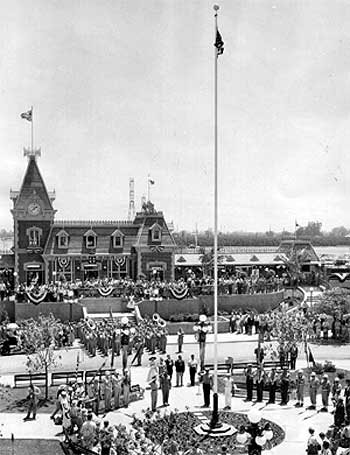
Disneyland's dedication ceremony on July 17, 1955.
Copyright Disney Enterprises, Inc.
All rights reserved
EDITOR'S NOTE: In the spirit of full disclosure, I guess
that I should note here that I did not actually pay for this copy of Theodore
Kinni's newest book. Disney Publishing provided me with a review copy of "Be
Our Guest" back in November for gratis.
History
The Evolution and History of Mickey’s ToonTown

Disneyland in Anaheim, California, holds a special place in the hearts of Disney fans worldwide, I mean heck, it’s where the magic began after all. Over the years it’s become a place that people visit in search of memorable experiences. One fan favorite area of the park is Mickey’s Toontown, a unique land that lets guests step right into the colorful, “Toony” world of Disney animation. With the recent reimagining of the land and the introduction of Micky and Minnies Runaway Railway, have you ever wondered how this land came to be?
There is a fascinating backstory of how Mickey’s Toontown came into existence. It’s a tale of strategic vision, the influence of Disney executives, and a commitment to meeting the needs of Disney’s valued guests.
The Beginning: Mickey’s Birthdayland
The story of Mickey’s Toontown starts with Mickey’s Birthdayland at Walt Disney World’s Magic Kingdom. Opened in 1988 to celebrate Mickey Mouse’s 60th birthday, this temporary attraction was met with such overwhelming popularity that it inspired Disney executives to think bigger. The idea was to create a permanent, immersive land where guests could step into the animated world of Mickey Mouse and his friends.
In the early ’90s, Disneyland was in need of a refresh. Michael Eisner, the visionary leader of The Walt Disney Company at the time, had an audacious idea: create a brand-new land in Disneyland that would celebrate Disney characters in a whole new way. This was the birth of Mickey’s Toontown.
Initially, Disney’s creative minds toyed with various concepts, including the idea of crafting a 100-Acre Woods or a land inspired by the Muppets. However, the turning point came when they considered the success of “Who Framed Roger Rabbit.” This film’s popularity and the desire to capitalize on contemporary trends set the stage for Toontown’s creation.
From Concept to Reality: The Birth of Toontown
In 1993, Mickey’s Toontown opened its gates at Disneyland, marking the first time in Disney Park history where guests could experience a fully realized, three-dimensional world of animation. This new land was not just a collection of attractions but a living, breathing community where Disney characters “lived,” worked, and played.
Building Challenges: Innovative Solutions
The design of Mickey’s Toontown broke new ground in theme park aesthetics. Imagineers were tasked with bringing the two-dimensional world of cartoons into a three-dimensional space. This led to the creation of over 2000 custom-built props and structures that embodied the ‘squash and stretch’ principle of animation, giving Toontown its distinctiveness.
And then there was also the challenge of hiding the Team Disney Anaheim building, which bore a striking resemblance to a giant hotdog. The Imagineers had to think creatively, using balloon tests and imaginative landscaping to seamlessly integrate Toontown into the larger park.

Key Attractions: Bringing Animation to Life
Mickey’s Toontown featured several groundbreaking attractions. “Roger Rabbit’s Car Toon Spin,” inspired by the movie “Who Framed Roger Rabbit,” became a staple of Toontown, offering an innovative ride experience. Gadget’s Go-Coaster, though initially conceived as a Rescue Rangers-themed ride, became a hit with younger visitors, proving that innovative design could create memorable experiences for all ages.
Another crown jewel of Toontown is Mickey’s House, a walkthrough attraction that allowed guests to explore the home of Mickey Mouse himself. This attraction was more than just a house; it was a carefully crafted piece of Disney lore. The house was designed in the American Craftsman style, reflecting the era when Mickey would have theoretically purchased his first home in Hollywood. The attention to detail was meticulous, with over 2000 hand-crafted, custom-built props, ensuring that every corner of the house was brimming with character and charm. Interestingly, the design of Mickey’s House was inspired by a real home in Wichita Falls, making it a unique blend of real-world inspiration and Disney magic.
Mickey’s House also showcased Disney’s commitment to creating interactive and engaging experiences. Guests could make themselves at home, sitting in Mickey’s chair, listening to the radio, and exploring the many mementos and references to Mickey’s animated adventures throughout the years. This approach to attraction design – where storytelling and interactivity merged seamlessly – was a defining characteristic of ToonTown’s success.

Executive Decisions: Shaping ToonTown’s Unique Attractions
The development of Mickey’s Toontown wasn’t just about creative imagination; it was significantly influenced by strategic decisions from Disney executives. One notable input came from Jeffrey Katzenberg, who suggested incorporating a Rescue Rangers-themed ride. This idea was a reflection of the broader Disney strategy to integrate popular contemporary characters and themes into the park, ensuring that the attractions remained relevant and engaging for visitors.
In addition to Katzenberg’s influence, Frank Wells, the then-President of The Walt Disney Company, played a key role in the strategic launch of Toontown’s attractions. His decision to delay the opening of “Roger Rabbit’s Car Toon Spin” until a year after Toontown’s debut was a calculated move. It was designed to maintain public interest in the park by offering new experiences over time, thereby giving guests more reasons to return to Disneyland.
These executive decisions highlight the careful planning and foresight that went into making Toontown a dynamic and continuously appealing part of Disneyland. By integrating current trends and strategically planning the rollout of attractions, Disney executives ensured that Toontown would not only capture the hearts of visitors upon its opening but would continue to draw them back for new experiences in the years to follow.
Global Influence: Toontown’s Worldwide Appeal
The concept of Mickey’s Toontown resonated so strongly that it was replicated at Tokyo Disneyland and influenced elements in Disneyland Paris and Hong Kong Disneyland. Each park’s version of Toontown maintained the core essence of the original while adapting to its cultural and logistical environment.
Evolution and Reimagining: Toontown Today
As we approach the present day, Mickey’s Toontown has recently undergone a significant reimagining to welcome “Mickey & Minnie’s Runaway Railway” in 2023. This refurbishment aimed to enhance the land’s interactivity and appeal to a new generation of Disney fans, all while retaining the charm that has made ToonTown a beloved destination for nearly three decades.

Dive Deeper into ToonTown’s Story
Want to know more about Mickey’s Toontown and hear some fascinating behind-the-scenes stories, then check out the latest episode of Disney Unpacked on Patreon @JimHillMedia. In this episode, the main Imagineer who worked on the Toontown project shares lots of interesting stories and details that you can’t find anywhere else. It’s full of great information and fun facts, so be sure to give it a listen!
History
Unpacking the History of the Pixar Place Hotel

Pixar Place Hotel, the newly unveiled 15-story tower at the Disneyland Resort, has been making waves in the Disney community. With its unique Pixar-themed design, it promises to be a favorite among visitors.
However, before we delve into this exciting addition to the Disneyland Resort, let’s take a look at the fascinating history of this remarkable hotel.
The Emergence of the Disneyland Hotel
To truly appreciate the story of the Pixar Place Hotel, we must turn back the clock to the early days of Disneyland. While Walt Disney had the visionary ideas and funding to create the iconic theme park, he faced a challenge when it came to providing accommodations for the park’s visitors. This is where his friend Jack Wrather enters the picture.
Jack Wrather, a fellow pioneer in the television industry, stepped in to assist Walt Disney in realizing his dream. Thanks to the success of the “Lassie” TV show produced by Wrather’s company, he had the financial means to build a hotel right across from Disneyland.
The result was the Disneyland Hotel, which opened its doors in October 1955. Interestingly, the early incarnation of this hotel had more of a motel feel than a hotel, with two-story buildings reminiscent of the roadside motels popular during the 1950s. The initial Disneyland Hotel consisted of modest structures that catered to visitors looking for affordable lodging close to the park. While the rooms were basic, it marked the beginning of something extraordinary.
The Evolution: From Emerald of Anaheim to Paradise Pier
As Disneyland’s popularity continued to soar, so did the demand for expansion and improved accommodations. In 1962, the addition of an 11-story tower transformed the Disneyland Hotel, marking a significant transition from a motel to a full-fledged hotel.
The addition of the 11-story tower elevated the Disneyland Hotel into a more prominent presence on the Anaheim skyline. At the time, it was the tallest structure in all of Orange County. The hotel’s prime location across from Disneyland made it an ideal choice for visitors. With the introduction of the monorail linking the park and the hotel, accessibility became even more convenient. Unique features like the Japanese-themed reflecting pools added to the hotel’s charm, reflecting a cultural influence that extended beyond Disney’s borders.
Japanese Tourism and Its Impact
During the 1960s and 1970s, Disneyland was attracting visitors from all corners of the world, including Japan. A significant number of Japanese tourists flocked to Anaheim to experience Walt Disney’s creation. To cater to this growing market, it wasn’t just the Disneyland Hotel that aimed to capture the attention of Japanese tourists. The Japanese Village in Buena Park, inspired by a similar attraction in Nara, Japan, was another significant spot.
These attractions sought to provide a taste of Japanese culture and hospitality, showcasing elements like tea ceremonies and beautiful ponds with rare carp and black swans. However, the Japanese Village closed its doors in 1975, likely due to the highly competitive nature of the Southern California tourist market.
The Emergence of the Emerald of Anaheim
With the surge in Japanese tourism, an opportunity arose—the construction of the Emerald of Anaheim, later known as the Disneyland Pacific Hotel. In May 1984, this 15-story hotel opened its doors.
What made the Emerald unique was its ownership. It was built not by The Walt Disney Company or the Oriental Land Company (which operated Tokyo Disneyland) but by the Tokyu Group. This group of Japanese businessmen already had a pair of hotels in Hawaii and saw potential in Anaheim’s proximity to Disneyland. Thus, they decided to embark on this new venture, specifically designed to cater to Japanese tourists looking to experience Southern California.
Financial Challenges and a Changing Landscape
The late 1980s brought about two significant financial crises in Japan—the crash of the NIKKEI stock market and the collapse of the Japanese real estate market. These crises had far-reaching effects, causing Japanese tourists to postpone or cancel their trips to the United States. As a result, reservations at the Emerald of Anaheim dwindled.
To adapt to these challenging times, the Tokyu Group merged the Emerald brand with its Pacific hotel chain, attempting to weather the storm. However, the financial turmoil took its toll on the Emerald, and changes were imminent.
The Transition to the Disneyland Pacific Hotel
In 1995, The Walt Disney Company took a significant step by purchasing the hotel formerly known as the Emerald of Anaheim for $35 million. This acquisition marked a change in the hotel’s fortunes. With Disney now in control, the hotel underwent a name change, becoming the Disneyland Pacific Hotel.
Transformation to Paradise Pier
The next phase of transformation occurred when Disney decided to rebrand the hotel as Paradise Pier Hotel. This decision aligned with Disney’s broader vision for the Disneyland Resort.
While the structural changes were limited, the hotel underwent a significant cosmetic makeover. Its exterior was painted to complement the color scheme of Paradise Pier, and wave-shaped crenellations adorned the rooftop, creating an illusion of seaside charm. This transformation was Disney’s attempt to seamlessly integrate the hotel into the Paradise Pier theme of Disney’s California Adventure Park.
Looking Beyond Paradise Pier: The Shift to Pixar Place
In 2018, Disneyland Resort rebranded Paradise Pier as Pixar Pier, a thematic area dedicated to celebrating the beloved characters and stories from Pixar Animation Studios. As a part of this transition, it became evident that the hotel formally known as the Disneyland Pacific Hotel could no longer maintain its Paradise Pier theme.
With Pixar Pier in full swing and two successful Pixar-themed hotels (Toy Story Hotels in Shanghai Disneyland and Tokyo Disneyland), Disney decided to embark on a new venture—a hotel that would celebrate the vast world of Pixar. The result is Pixar Place Hotel, a 15-story tower that embraces the characters and stories from multiple Pixar movies and shorts. This fully Pixar-themed hotel is a first of its kind in the United States.
The Future of Pixar Place and Disneyland Resort
As we look ahead to the future, the Disneyland Resort continues to evolve. The recent news of a proposed $1.9 billion expansion as part of the Disneyland Forward project indicates that the area surrounding Pixar Place is expected to see further changes. Disneyland’s rich history and innovative spirit continue to shape its destiny.
In conclusion, the history of the Pixar Place Hotel is a testament to the ever-changing landscape of Disneyland Resort. From its humble beginnings as the Disneyland Hotel to its transformation into the fully Pixar-themed Pixar Place Hotel, this establishment has undergone several iterations. As Disneyland Resort continues to grow and adapt, we can only imagine what exciting developments lie ahead for this iconic destination.
If you want to hear more stories about the History of the Pixar Place hotel, check our special edition of Disney Unpacked over on YouTube.
Stay tuned for more updates and developments as we continue to explore the fascinating world of Disney, one story at a time.
History
From Birthday Wishes to Toontown Dreams: How Toontown Came to Be

In the latest release of Episode 4 of Disney Unpacked, Len and I return, joined as always by Disney Imagineering legend, Jim Shull. This two-part episode covers all things Mickey’s Birthday Land and how it ultimately led to the inspiration behind Disneyland’s fan-favorite land, “Toontown”. But let’s not get ahead of ourselves here. It all starts in the early days at Disneyland.
Early Challenges in Meeting Mickey
Picture this: it’s the late 1970s and early 1980s, and you’re at Disneyland. You want to meet the one and only Mickey Mouse, but there’s no clear way to make it happen. You rely on Character Guides, those daily printed sheets that point you in Mickey’s general direction. But let’s be honest, it was like finding a needle in a haystack. Sometimes, you got lucky; other times, not so much.

Mickey’s Birthdayland: A Birthday Wish that Came True
Fast forward to the late 1980s. Disney World faced a big challenge. The Disney-MGM Studios Theme Park was under construction, with the company’s marketing machine in full swing, hyping up the opening of Walt Disney World’s third theme park, MGM Studios, in the Spring of 1989. This extensive marketing meant that many people were opting to postpone their family’s next trip to Walt Disney World until the following year. Walt Disney World needed something compelling to motivate guests to visit Florida in 1988, the year before Disney MGM Studios opened.
Enter stage left, Mickey’s Birthdayland. For the first time ever, an entire land was dedicated to a single character – and not just any character, but the mouse who started it all. Meeting Mickey was no longer a game of chance; it was practically guaranteed.

The Birth of Birthdayland: Creative Brilliance Meets Practicality
In this episode, we dissect the birth of Mickey’s Birthdayland, an initiative that went beyond celebrating a birthday. It was a calculated move, driven by guest feedback and a need to address issues dating back to 1971. Imagineers faced the monumental task of designing an experience that honored Mickey while efficiently managing the crowds. This required the perfect blend of creative flair and logistical prowess – a hallmark of Disney’s approach to theme park design.
Evolution: From Birthdayland to Toontown
The success of Mickey’s Birthdayland was a real game-changer, setting the stage for the birth of Toontown – an entire land that elevated character-centric areas to monumental new heights. Toontown wasn’t merely a spot to meet characters; it was an immersive experience that brought Disney animation to life. In the episode, we explore its innovative designs, playful architecture, and how every nook and cranny tells a story.

Impact on Disney Parks and Guests
Mickey’s Birthdayland and Toontown didn’t just reshape the physical landscape of Disney parks; they transformed the very essence of the guest experience. These lands introduced groundbreaking ways for visitors to connect with their beloved characters, making their Disney vacations even more unforgettable.
Beyond Attractions: A Cultural Influence
But the influence of these lands goes beyond mere attractions. Our episode delves into how Mickey’s Birthdayland and Toontown left an indelible mark on Disney’s culture, reflecting the company’s relentless dedication to innovation and guest satisfaction. It’s a journey into how a single idea can grow into a cherished cornerstone of the Disney Park experience.

Unwrapping the Full Story of Mickey’s Birthdayland
Our two-part episode of Disney Unpacked is available for your viewing pleasure on our Patreon page. And for those seeking a quicker Disney fix, we’ve got a condensed version waiting for you on our YouTube channel. Thank you for being a part of our Disney Unpacked community. Stay tuned for more episodes as we continue to “Unpack” the fascinating world of Disney, one story at a time.
-
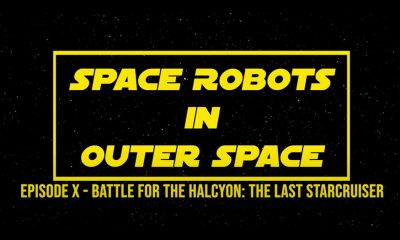
 News & Press Releases12 months ago
News & Press Releases12 months agoStar Wars Spoof: Space Robots in Outer Space Ep X: Battle for the Halcyon: The Last Starcruiser
-

 History11 months ago
History11 months ago31 Long-Gone Rides, Shows & Attractions at Disney-MGM (Hollywood Studios)
-

 News & Press Releases8 months ago
News & Press Releases8 months agoDisney Will Bring D23: The Ultimate Disney Fan Event to Anaheim, California in August 2024
-

 Theme Parks & Themed Entertainment11 months ago
Theme Parks & Themed Entertainment11 months agoFrom Aladdin to Indy – How Did We Get an Indiana Jones Stage Show at Disneyland?
-

 History3 months ago
History3 months agoFrom Birthday Wishes to Toontown Dreams: How Toontown Came to Be
-

 Theme Parks & Themed Entertainment12 months ago
Theme Parks & Themed Entertainment12 months agoHow Did We Get “Aladdin’s Oasis” at Disneyland?
-

 Theme Parks & Themed Entertainment10 months ago
Theme Parks & Themed Entertainment10 months agoWhen WDW Had a Racetrack – The Creation of the Walt Disney World Speedway
-

 Film & Movies10 months ago
Film & Movies10 months ago“Indiana Jones and the Search for Indiana Jones”








